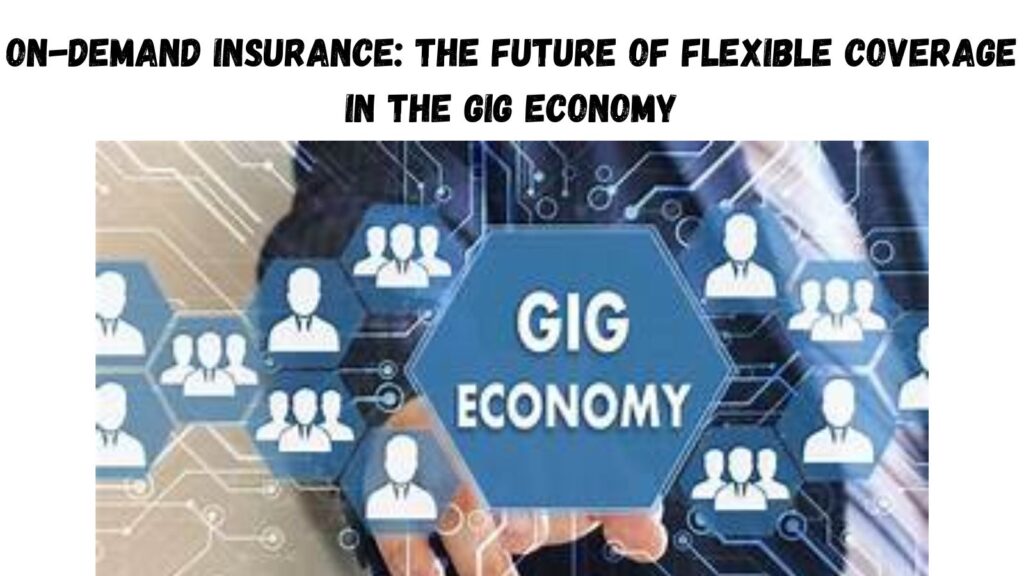The world is rapidly changing, and so is the way we buy insurance. In the past, traditional insurance policies came with fixed premiums and long-term commitments. With the gig economy growing, freelancers, contractors, and temporary workers need flexible, short-term coverage more than ever. Enter on-demand insurance: a modern solution that offers coverage for short periods—sometimes as brief as a day or week.
On-demand insurance is a flexible product. It caters to the needs of today’s workers and consumers who want coverage only when they need it. On-demand insurance is a great choice. It’s affordable and convenient. Whether you’re a rideshare driver for a day, a freelancer on a short project, or a traveler renting a car, it meets your needs.

This guide covers how on-demand insurance works, who it helps, real-life examples, and why it’s essential today.
What is On-Demand Insurance?
Contents
- 1 What is On-Demand Insurance?
- 2 Why is On-Demand Insurance Gaining Popularity?
- 3 Real-Time Examples of On-Demand Insurance
- 4 How On-Demand Insurance Works
- 5 Benefits of On-Demand Insurance
- 6 Interesting Story: The Freelancer’s Experience with On-Demand Insurance
- 7 Conclusion
- 8 FAQs About On-Demand Insurance
- 9 What is on-demand insurance?
- 10 Who benefits from on-demand insurance?
- 11 Is on-demand insurance more affordable than traditional insurance?
- 12 How do I activate on-demand insurance?
- 13 Can I turn off on-demand insurance after the coverage period ends?
On-demand insurance is a flexible policy. It lets people buy coverage for specific, short-term needs. This coverage can last from a few hours to several weeks, depending on the situation. The goal is to let customers choose how and when to use insurance. This way, they can skip the long-term commitments and high premiums of regular policies.
On-demand insurance is different from regular insurance. With regular insurance, you pay a set premium for a year. But with on-demand insurance, you can turn coverage on or off as you need it. It’s great for people with irregular work schedules. This includes gig workers, travelers, and people needing short-term protection for one-time tasks.
Key Features of On-Demand Insurance:
- Short-Term Coverage: Insurance is activated only when needed, such as for a specific task or time period.
- Flexibility: Users can turn coverage on and off based on their needs.
- Customizable: Policies cover specific activities, like driving, renting equipment, or traveling.
- Instant Activation: Many on-demand policies can be activated in minutes, often via a mobile app or website.
- Pay-per-Use Model: Premiums are paid based on the length and type of coverage, ensuring cost-efficiency.
Why is On-Demand Insurance Gaining Popularity?
The gig economy is growing. More people are leaving traditional 9-to-5 jobs. They are choosing flexible, temporary, and freelance work instead. This shift has created a gap in the insurance market, as many gig workers don’t need full-time coverage. On-demand insurance steps in to fill this gap, offering a solution that aligns with the needs of modern workers.
Some of the main drivers of on-demand insurance’s popularity include:
- Growth of the Gig Economy: Millions now work as freelancers, contractors, or in temporary jobs. On-demand insurance offers flexible and affordable coverage for those lacking traditional employment benefits.
- Affordability: Unlike traditional insurance policies, which can be expensive, on-demand policies are cost-effective. Customers only pay for the coverage they need when they need it, avoiding unnecessary expenses.
- Convenience: Mobile technology and digital platforms make activating on-demand insurance very easy now. You can purchase coverage in real-time through apps or websites, making it incredibly convenient for users.
- Changing Consumer Expectations: Consumers expect flexibility in services like streaming and food delivery. Now, they expect the same from their insurance providers.
- Short-Term Needs: Traditional policies are often too strict for those needing insurance for specific, short-term events or projects. On-demand insurance caters to these specific needs, from renting a car to covering a temporary work gig.
Real-Time Examples of On-Demand Insurance
To understand how on-demand insurance is used, let’s look at some real-world examples:
1. Rideshare Drivers
Imagine you’re a rideshare driver working with Uber or Lyft. While you’re driving, you’re required to have insurance, but you don’t necessarily need full coverage when you’re off the road. On-demand insurance allows you to activate coverage only when you’re driving passengers. If you get into an accident during a trip, your insurance covers you; when you’re not driving, there’s no need to keep paying for insurance. This is ideal for people who only need insurance for certain activities.
Example:
Rideshare drivers in cities like New York or San Francisco can save hundreds each year. They just need to turn off their on-demand auto insurance when they’re not working.
2. Freelancers and Contractors
Freelancers often don’t have the luxury of employer-provided insurance. If you’re a photographer, graphic designer, or consultant, you may only need coverage for specific jobs or projects. On-demand insurance lets you turn on coverage only when you need it. This way, you’re protected from liability or accidents at work without paying for a full year.
Example:
A freelance photographer can get on-demand insurance for a weekend event. This covers their equipment and liability while they work. They don’t need to buy a full policy for the whole year.
3. Travelers and Car Rentals
When you rent a car, the rental company often offers insurance. Many travelers might think these policies are too costly or not needed. They may already have coverage from their personal auto insurance. On-demand insurance lets travelers buy coverage only for their rental period. This way, they get the protection they need without paying for extra.
Example:
A traveler renting a car for a week can buy on-demand insurance. This temporary policy protects the car and covers incidents during the trip. It also helps avoid the high costs of rental company insurance.
How On-Demand Insurance Works
These platforms make things easy. They cut out paperwork, so users often get quick confirmation of their coverage.
Here’s a simple breakdown of how it works:
- Sign Up: You sign up on an app or website to create an account.
- Select Coverage: You choose the type of coverage you need (e.g., auto, equipment, liability).
- Set Duration: You specify the start and end time for the coverage.
- Pay for Coverage: You pay for the coverage based on the duration and type of policy.
- Activate and Use: Once activated, you’re covered for the specified time period.
- Deactivate After Use: When the coverage period ends, the policy deactivates. No more payments are needed.
Benefits of On-Demand Insurance
- Flexibility: The most significant benefit is flexibility. You pay for insurance only when you need it.
- Cost Efficiency: On-demand insurance costs less than traditional policies. You pay only for the exact time you need coverage.
- Quick Coverage: Many providers give you instant coverage with just a few clicks. It’s super easy!
- Custom Fit for You: On-demand insurance lets you tailor coverage for your needs. Whether it’s for car rentals, freelance work, or events, you get the protection you want.
- On-demand insurance is a great option for gig workers. They don’t need costly, full-time policies.
Interesting Story: The Freelancer’s Experience with On-Demand Insurance
Meet Alex, a freelance graphic designer in Chicago. Alex often takes on short-term projects for different clients. He doesn’t need full-time insurance coverage. One day, Alex was hired for a last-minute project that required him to rent a special piece of equipment—a camera worth $3,000. Alex chose an on-demand insurance service instead of paying for a full year. This way, he bought coverage just for the weekend. It ensured his equipment was protected during the job. The cost of the insurance was a fraction of what traditional policies would have charged, saving Alex a lot of money.
Conclusion
On-demand insurance is revolutionizing the way we think about insurance coverage. It offers flexibility, saves money, and is easy to access. This is great for those who don’t need standard, long-term policies. On-demand insurance is great for gig workers, travelers, or anyone needing short-term coverage. You can turn it on when you need protection and off when you don’t.
As the gig economy continues to grow, on-demand insurance is likely to become even more mainstream. It’s great for anyone needing short-term coverage. It offers flexibility and affordability that regular policies can’t match.
Consumer Benefits: Why Tech-Driven Insurance Is the Future
FAQs About On-Demand Insurance
What is on-demand insurance?
On-demand insurance is a flexible insurance policy that provides coverage for short periods of time. Users can turn coverage on and off when they need to. This gives them convenience and saves money.
Who benefits from on-demand insurance?
On-demand insurance helps gig economy workers, freelancers, travelers, and others. It’s great for those needing short-term coverage for activities like car rentals, equipment use, or ridesharing.
Is on-demand insurance more affordable than traditional insurance?
Yes, on-demand insurance is typically cheaper because you only pay for the coverage you need, rather than a long-term, fixed premium.
How do I activate on-demand insurance?
On-demand insurance is usually activated through a mobile app or website. Choose the coverage type, set the duration, and pay for the service. You usually get confirmation right away.
Can I turn off on-demand insurance after the coverage period ends?
Yes, once the coverage period is over, the insurance is automatically deactivated, and no further payments are required.
On-demand insurance is changing the insurance industry. It offers a modern and flexible way to get protection. It’s a solution for people who need coverage only when it makes sense, without paying for something they won’t use. On-demand insurance can save you time, money, and stress. This is true whether you’re driving for a rideshare company or renting a car for a weekend trip.


